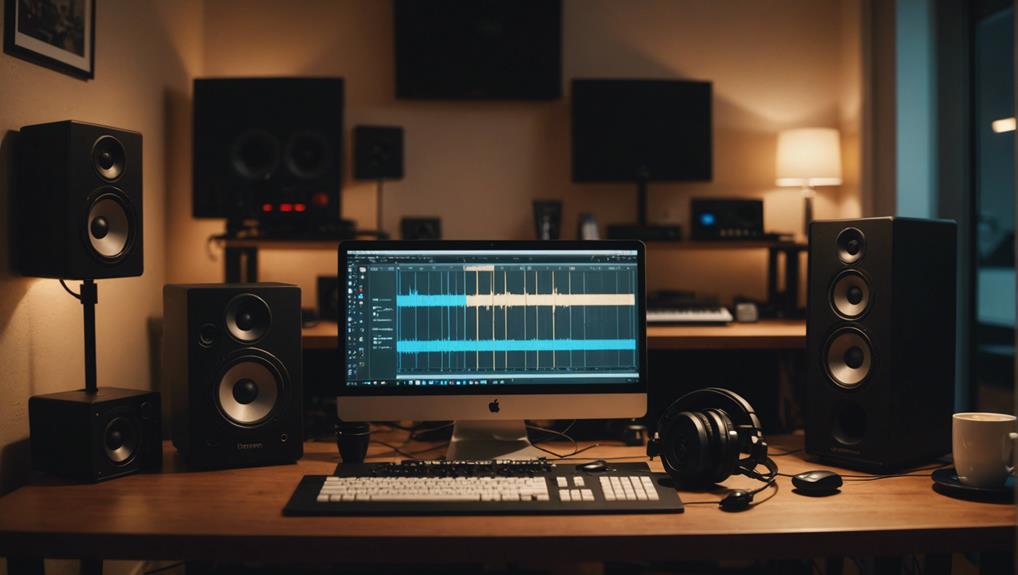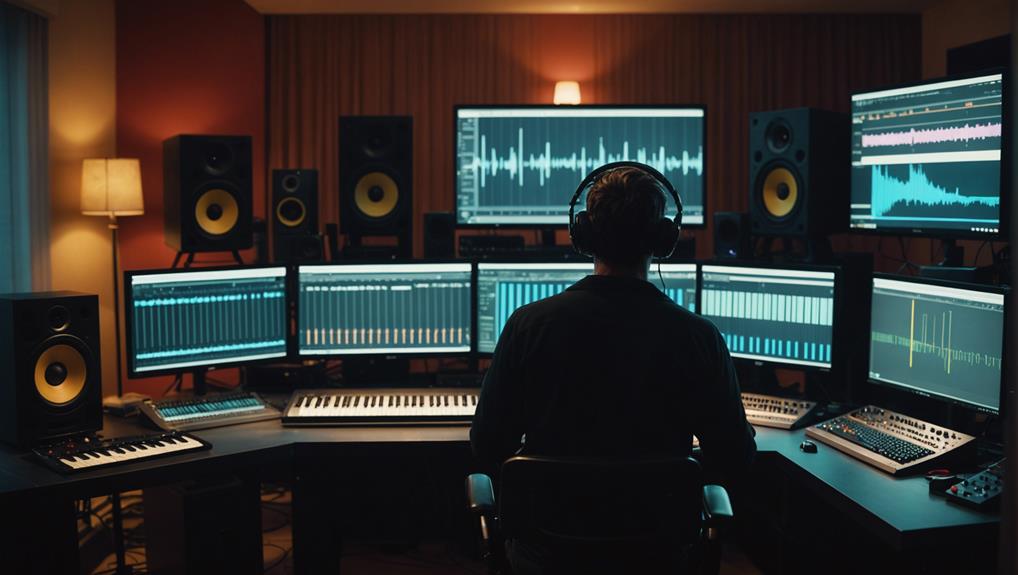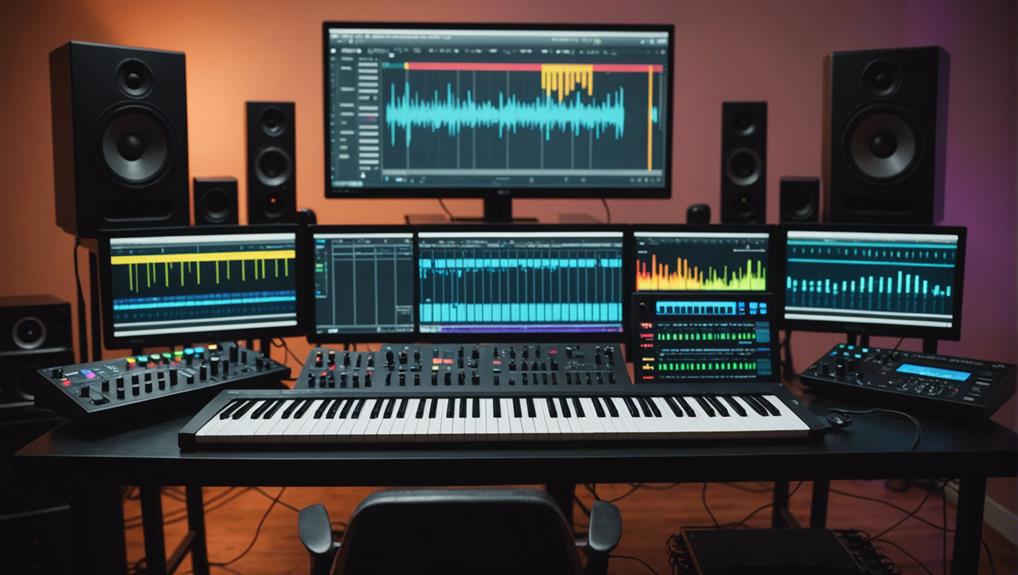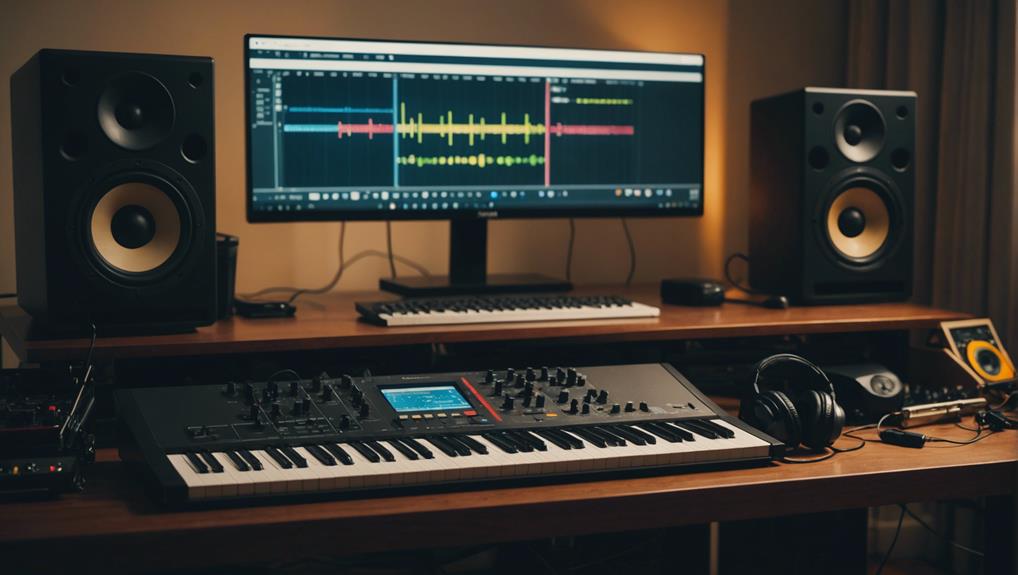When you’re starting out in sound design, grasping the basics of sound creation is essential. You’ll need to understand how vibrations translate into pitch and volume, giving you the foundation to create and manipulate sounds effectively. Your journey will involve exploring various tools like synthesizers and samplers, and mastering recording techniques. But the real magic begins when you start sampling from diverse sources and layering these sounds in innovative ways. Once you get a handle on synthesizing and adding effects, you’ll be well on your way to crafting a unique style. Curious about where to start? Let’s break it down.
TL-DR
- Start by understanding the basics of sound, including pitch, frequency, and amplitude.
- Use DAWs to record, edit, and enhance audio with a structured workflow.
- Experiment with layering and manipulating samples to create unique soundscapes.
- Explore synthesizer basics, like waveforms and envelopes, to generate new sounds.
- Apply effects like reverb and delay to add depth and movement to your sounds.
Understanding Sound Basics
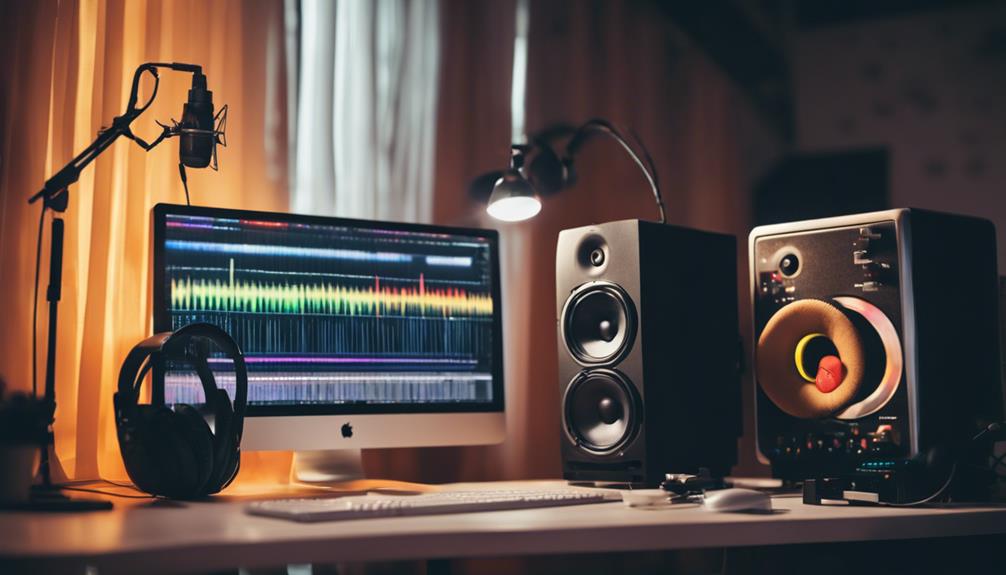
To get started in sound design, you need to understand the basics of how sound works. Sound is fundamentally created by vibrating air molecules. These vibrations produce waves that your ears interpret as sound. The pitch of a sound is determined by its frequency, which is how many times the wave vibrates per second.
Humans can hear a range of audio frequencies from 20 Hz to 20,000 Hz. The volume, or loudness, of a sound is determined by its amplitude, which is the height of the sound wave.
Different sounds are made up of multiple frequencies. The fundamental frequency is the strongest and most dominant frequency in a sound, while overtones add richness and complexity. Overtones can be harmonic, aligning with the fundamental frequency, or inharmonic, creating more complex tones.
As a sound designer, you’ll need to manipulate these air vibrations to create specific sound signals. Whether you’re mimicking real-world instruments or experimenting with new sounds, understanding how to manipulate audio frequencies is essential.
You’ll use various manipulation tools to shape and create sounds, achieving the desired effect through precise control of frequency, amplitude, and overtones.
Choosing Sound Design Tools
Selecting the right sound design tools is crucial for bringing your creative audio visions to life. You’ll want to start by exploring synthesizers, which are fantastic for generating new sounds from scratch. They use different waveforms and modulation techniques, allowing you to craft unique audio textures and effects.
If you’re interested in manipulating and triggering recorded sounds, samplers are your go-to option. These tools are perfect for creating distinctive textures and effects by reworking existing audio clips.
Field recordings are another essential tool in your sound design arsenal. They enable you to capture real-world sounds, which you can then manipulate and integrate into your projects. These recordings add an organic element to your work, making your soundscapes more immersive.
Don’t overlook the power of Digital Audio Workstations (DAWs). DAWs are indispensable for editing, processing, and arranging your sound elements. They provide a complete environment where you can manage all aspects of your sound design, from layering textures to applying various effects and modulation techniques.
Recording and Editing
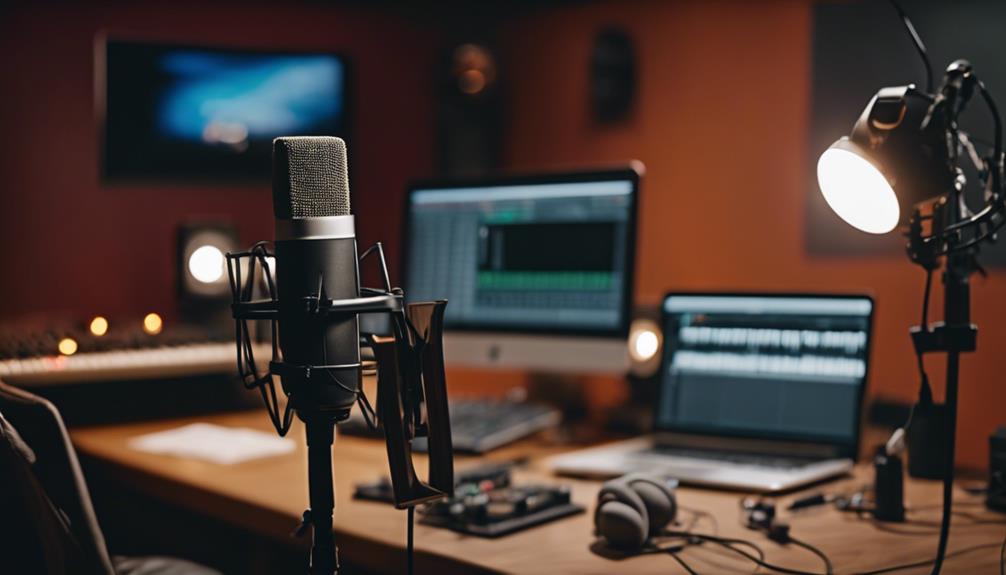
Ever wondered how to capture and refine the perfect sound for your project? Recording and editing are essential steps in sound design. To start, you’ll need to capture audio using microphones, field recorders, or digital audio workstations (DAWs). Popular DAWs like Audacity, Adobe Audition, Pro Tools, and GarageBand are excellent tools for this purpose.
Once you’ve got your recordings, the real magic happens during the editing phase. Editing involves cutting, splicing, arranging, and manipulating your audio to fit your project’s needs. This process helps you refine your sound, making it clearer and more impactful. Adding effects, adjusting levels, and removing noise are vital techniques to enhance sound quality.
A well-organized editing workflow ensures that your recorded audio integrates seamlessly into your overall sound design. By systematically arranging and manipulating your audio, you can achieve a coherent and polished final product.
Don’t forget to experiment with different effects to add depth and character to your sound.
Mastering recording and editing will elevate your sound design projects, making them more professional and engaging. So, immerse yourself, experiment, and watch your audio visions come to life!
Exploring Sampling Techniques
When exploring sampling techniques, start by choosing diverse and interesting sample sources that fit your creative vision.
Next, experiment with layering and manipulating these samples to craft unique sounds.
Choosing Sample Sources
Immerse yourself in the world of sound design by exploring diverse sample sources like clinking glass, rustling leaves, or a friend’s laughter. Sampling involves recording and manipulating real-world sounds to create new and unique audio textures. By exploring various sample sources, you open up endless creative possibilities in your sound design projects.
When choosing sample sources, consider these three categories:
- Everyday Objects: Items around your home or studio can produce fascinating sounds. Think of the rhythmic tapping of a pencil, the creak of a door, or the gentle hum of an appliance. These can be recorded using microphones or field recorders and offer unique sonic elements.
- Nature Sounds: Head outdoors with a field recorder to capture the ambient sounds of nature. Birds chirping, water flowing, and wind blowing through trees can add a natural and organic touch to your audio palette.
- Human Voices: Vocal recordings, whether it’s spoken word, singing, or even laughter, provide a rich source of material. You can manipulate these recordings to create interesting effects or integrate them into your soundscapes.
Exploring these varied sample sources allows you to craft unique audio textures and expand your sound design toolkit.
Layering and Manipulation Techniques
Now that you’ve explored various sample sources, let’s focus on layering and manipulating these sounds to create rich and complex audio textures.
In sound design, layering involves combining multiple sound sources to craft a fuller, more intricate soundscape. Start by selecting a few samples that complement each other and stack them together. This layering adds depth, texture, and uniqueness to your project.
Manipulation is where sampling techniques truly shine. Use effects like reverb, delay, and distortion to alter your samples. EQ can help you carve out frequency spaces for each layer, ensuring they don’t clash. Modulation effects like chorus, flanger, and phaser can transform ordinary sounds into something extraordinary.
Don’t be afraid of creative experimentation. Try pitching samples up or down, reversing them, or time-stretching them to fit your needs. The goal is customization—making the sounds your own.
Whether you’re working on music, film, or any other audio project, these techniques allow for endless possibilities. By mastering layering and manipulation, you’ll elevate your sound design skills and create audio that’s truly standout.
Synthesizing Sounds
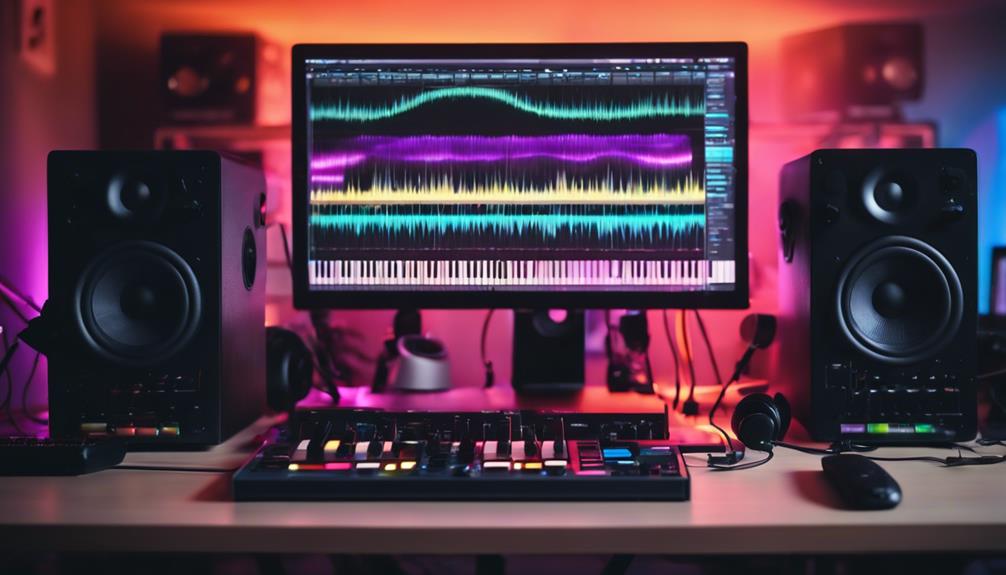
Synthesizing sounds means you’re generating audio signals using electronic devices like synthesizers, creating everything from basic tones to complex textures. In sound design, synthesizing sounds starts with selecting waveforms such as sine, square, triangle, and sawtooth. These waveforms are the fundamental building blocks that define the initial tonal quality of your sound.
Next, you’ll shape the sound using envelopes, typically ADSR (Attack, Decay, Sustain, Release), which control how the sound evolves over time. By adjusting these parameters, you can craft everything from sharp, percussive hits to smooth, evolving pads.
Modulation techniques bring your sound to life by adding movement and variation. Low-Frequency Oscillators (LFOs) and other modulation sources can alter various aspects of your sound, creating dynamic textures and rhythms.
Here’s a quick rundown of essential elements:
- Waveforms: Choose from sine, square, triangle, and sawtooth to set your sound’s core character.
- Envelopes: Use ADSR envelopes to control the temporal shape of your sound.
- Modulation: Apply LFOs and other modulation techniques to introduce movement and complexity.
Lastly, don’t forget filters and effects. Filters help carve out specific frequencies, shaping the timbre, while effects like reverb and delay add depth and dimension. Synthesizing sounds is a creative process, so experiment with different combinations to find your unique sound.
Adding Effects and Modulation
Once you’ve crafted your initial sound through synthesis, it’s time to enhance it by adding effects and modulation for greater depth and complexity.
Effects are used to alter the characteristics of your sound in significant ways. Types of effects like reverb, delay, distortion, EQ, and compression can transform your sound from flat to dynamic. Reverb and delay add space, distortion adds grit, EQ shapes frequencies, and compression controls dynamics.
Modulation sources, such as LFOs, ADSR envelopes, and DAW automation, bring movement and dynamics to your sound. An ADSR envelope can shape the attack, decay, sustain, and release of a sound, adding natural progression. LFOs can modulate parameters like pitch or filter cutoff, creating a sense of motion.
Building an effective signal chain is essential. Start by placing your modulation sources and effects in an order that complements your sound. For instance, placing reverb after EQ can result in a cleaner reverb effect.
Experimenting with different settings is key to developing your unique style. Try varying the modulation rates or tweaking effect parameters to find what best suits your vision. This experimentation is vital for creating depth and achieving desired sonic results.
Next up, learn how to record vocals in this guide.
